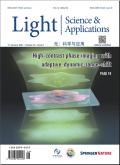Missing harmonic dynamics in generalized Snell's law: revealing full-channel characteristics of gradient metasurfaces.
IF 23.4
Q1 OPTICS
引用次数: 0
Abstract
The conventional generalized Snell's law (GSL), derived from classical laws of optical reflection and refraction, governs wavefront manipulation via phase gradients but neglects higher-order spatial harmonics inherently excited by the mutual coupling among meta-atoms on a metasurface. Here, we introduce a spatial harmonic-expanded GSL (SH-GSL) framework by unifying phase-gradient control with Floquet periodicity, establishing spatial harmonics as independent degrees of freedom rather than conventional parasitic disturbances. The SH-GSL framework rigorously identifies the intrinsic harmonic dynamics inherent to metasurfaces, which is a critical feature absent in GSL. Furthermore, this framework further reveals that all gradient-phase metasurfaces inherently function as multichannel platforms due to full spatial harmonics, with this multifunctionality rooted in nonlocal Floquet-Bloch modal interactions. Experimental validation demonstrates: abnormal spatial-harmonic reflection with angular precision ( < 5° deviation), multi-beam splitting (dual/quad configurations) via the relationship between specific harmonics and compensation wave vectors, and a perfect three-channel retroreflector achieving up to 99% efficiency, where parasitic harmonics are confined to near-field plasmonic regimes. This framework establishes a deterministic Floquet-engineered momentum compensation mechanism to simultaneously activate target harmonic channels while confining parasitic harmonics to near-field plasmonic regimes. Experimental validation confirms the framework's accuracy and scalability, bridging momentum-space physics with practical meta-plasmon systems. This work redefines metasurface engineering paradigms, unlocking advancements in ultra-dense beamforming, sensing, and meta-photonics through harmonic-division multiplexing.广义斯涅尔定律中的失谐动力学:揭示梯度超表面的全通道特性。
传统的广义斯涅尔定律(GSL)由经典的光学反射和折射定律推导而来,它通过相位梯度控制波前操作,但忽略了由超表面上元原子之间相互耦合激发的高阶空间谐波。本文通过将相位梯度控制与Floquet周期性统一起来,引入空间谐波扩展GSL (SH-GSL)框架,将空间谐波作为独立的自由度而不是传统的寄生扰动。SH-GSL框架严格识别了元表面固有的内在谐波动力学,这是GSL中缺乏的关键特征。此外,该框架进一步揭示了所有梯度相位元表面由于全空间谐波而固有地作为多通道平台,这种多功能性根植于非局部Floquet-Bloch模态相互作用。实验验证表明:具有角精度的异常空间谐波反射(< 5°偏差),通过特定谐波和补偿波矢量之间的关系进行多波束分裂(双/四组配置),以及一个完美的三通道后向反射器,其效率高达99%,其中寄生谐波仅限于近场等离子体区域。该框架建立了一个确定性的floquet工程动量补偿机制,以同时激活目标谐波通道,同时将寄生谐波限制在近场等离子体区域。实验验证证实了该框架的准确性和可扩展性,将动量空间物理与实际的元等离子体系统连接起来。这项工作重新定义了超表面工程范式,通过谐波分复用解锁了超密集波束形成,传感和元光子学的进步。
本文章由计算机程序翻译,如有差异,请以英文原文为准。
求助全文
约1分钟内获得全文
求助全文
来源期刊

Light-Science & Applications
数理科学, 物理学I, 光学, 凝聚态物性 II :电子结构、电学、磁学和光学性质, 无机非金属材料, 无机非金属类光电信息与功能材料, 工程与材料, 信息科学, 光学和光电子学, 光学和光电子材料, 非线性光学与量子光学
自引率
0.00%
发文量
803
审稿时长
2.1 months
 求助内容:
求助内容: 应助结果提醒方式:
应助结果提醒方式:


